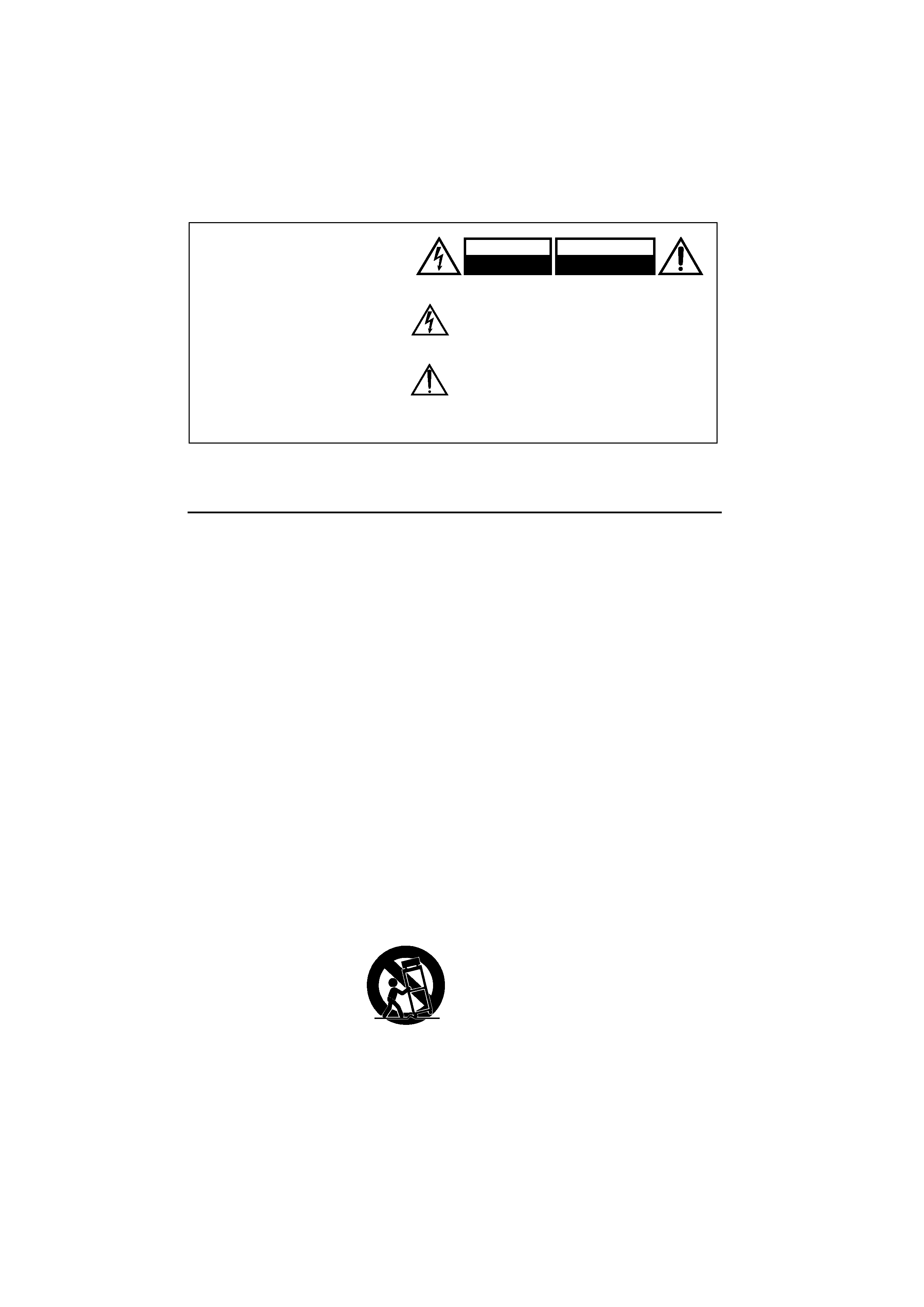
CD RECEIVER
CR-N1
Instruction Manual
Thank you for purchasing the ONKYO CR-N1 CD
Receiver.
Please read this manual thoroughly before mak-
ing any connection or turning on the power.
Follow these instructions to obtain optimum per-
formance and maximum listening enjoyment from
your new CR-N1. Please retain this manual for
future reference.
English
Before using
2
Controls & connectors
12
Getting connected
18
Basic operation
30
Playing CDs
35
Listening to the radio
41
Using the timer
47
Using USB
51
Appendix
58

2
WARNING:
TO REDUCE THE RISK OF FIRE
OR ELECTRIC SHOCK, DO NOT
EXPOSE THIS APPLIANCE TO
RAIN OR MOISTURE.
CAUTION:
TO REDUCE THE RISK OF
ELECTRIC SHOCK, DO NOT
REMOVE COVER (OR BACK). NO
USER-SERVICEABLE PARTS
INSIDE. REFER SERVICING TO
QUALIFIED SERVICE PERSONNEL.
The lightning flash with arrowhead symbol, within an
equilateral triangle, is intended to alert the user to the
presence of uninsulated "dangerous voltage" within the
product's enclosure that may be of sufficient magnitude
to constitute a risk of electric shock to persons.
The exclamation point within an equilateral triangle is
intended to alert the user to the presence of
important operating and maintenance (servicing)
instructions in the literature accompanying the
appliance.
WARNING
RISK OF ELECTRIC SHOCK
DO NOT OPEN
RISQUE DE CHOC ELECTRIQUE
NE PAS
OUVRIR
AVIS
PORTABLE CART WARNING
S3125A
Important Safeguards
1.
Read Instructions All the safety and
operating instructions should be read
before the appliance is operated.
2.
Retain Instructions The safety and oper-
ating instructions should be retained for
future reference.
3.
Heed Warnings All warnings on the
appliance and in the operating instruc-
tions should be adhered to.
4.
Follow Instructions All operating and
use instructions should be followed.
5.
Cleaning Unplug the appliance from the
wall outlet before cleaning. The appliance
should be cleaned only as recommended
by the manufacturer.
6.
Attachments Do not use attachments
not recommended by the appliance man-
ufacturer as they may cause hazards.
7.
Water and Moisture Do not use the
appliance near water for example, near a
bath tub, wash bowl, kitchen sink, or
laundry tub; in a wet basement; or near a
swimming pool; and the like.
8.
Accessories Do not place the appliance
on an unstable cart, stand, tripod,
bracket, or table.The appliance may fall,
causing serious injury to a child or adult,
and serious damage to the appliance. Use
only with a cart, stand, tripod, bracket, or
table recommended by the manufacturer,
or sold with the appliance.
Any mounting of the
appliance should follow
the manufacturer's instruc-
tions, and should use a
mounting accessory rec-
ommended by the manu-
facturer.
9.
An appliance and cart
combination should be moved with care.
Quick stops, excessive force, and uneven
surfaces may cause the appliance and cart
combination to overturn.
10. Ventilation Slots and openings in the cabi-
net are provided for ventilation and to
ensure reliable operation of the appliance
and to protect it from overheating, and
these openings must not be blocked or cov-
ered. The openings should never be blocked
by placing the appliance on a bed, sofa, rug,
or other similar surface. The appliance
should not be placed in a built-in installa-
tion such as a bookcase or rack unless
proper ventilation is provided. There should
be free space of at least 20 cm (8 in.) and an
opening behind the appliance.
11. Power Sources The appliance should be
operated only from the type of power
source indicated on the marking label. If
you are not sure of the type of power sup-
ply to your home, consult your appliance
dealer or local power company.
12. Grounding or Polarization The appliance
may be equipped with a polarized alter-
nating current line plug (a plug having
one blade wider than the other). This plug
will fit into the power outlet only one
way. This is a safety feature. If you are
unable to insert the plug fully into the
outlet, try reversing the plug. If the plug
should still fail to fit, contact your electri-
cian to replace your obsolete outlet. Do
not defeat the safety purpose of the
polarized plug.
13. Power-Cord Protection Power-supply
cords should be routed so that they are
not likely to be walked on or pinched by
items placed upon or against them, pay-
ing particular attention to cords at plugs,
convenience receptacles, and the point
where they exit from the appliance.

3
14. Outdoor Antenna Grounding If an out-
side antenna or cable system is connected
to the appliance, be sure the antenna or
cable system is grounded so as to provide
some protection against voltage surges
and built-up static charges. Article 810 of
the National Electrical Code, ANSI/NFPA
70, provides information with regard to
proper grounding of the mast and sup-
porting structure, grounding of the lead-
in wire to an antenna-discharge unit, size
of grounding conductors, location of
antenna-discharge unit, connection to
grounding electrodes, and requirements
for the grounding electrode. See Figure 1.
15. Lightning For added protection for the
appliance during a lightning storm, or
when it is left unattended and unused for
long periods of time, unplug it from the
wall outlet and disconnect the antenna or
cable system. This will prevent damage to
the appliance due to lightning and
power-line surges.
16. Power Lines An outside antenna system
should not be located in the vicinity of
overhead power lines or other electric
light or power circuits, or where it can fall
into such power lines or circuits. When
installing an outside antenna system,
extreme care should be taken to keep
from touching such power lines or circuits
as contact with them might be fatal.
17. Overloading Do not overload wall out-
lets, extension cords, or integral conve-
nience receptacles as this can result in a
risk of fire or electric shock.
18. Object and Liquid Entry Never push
objects of any kind into the appliance
through openings as they may touch dan-
gerous voltage points or short-out parts
that could result in a fire or electric shock.
Never spill liquid of any kind on the appli-
ance.
19. Servicing Do not attempt to service the
appliance yourself as opening or remov-
ing covers may expose you to dangerous
voltage or other hazards. Refer all servic-
ing to qualified service personnel.
20. Damage Requiring Service Unplug the
appliance form the wall outlet and refer
servicing to qualified service personnel
under the following conditions:
A. When the power-supply cord or plug is
damaged,
B. If liquid has been spilled, or objects
have fallen into the appliance,
C. If the appliance has been exposed to
rain or water,
D. If the appliance does not operate nor-
mally by following the operating
instructions. Adjust only those con-
trols that are covered by the operating
instructions as an improper adjustment
of other controls may result in damage
and will often require extensive work
by a qualified technician to restore the
appliance to its normal operation,
E. If the appliance has been dropped or
damaged in any way, and
F. When the appliance exhibits a distinct
change in performance this indicates
a need for service.
21. Replacement Parts When replacement
parts are required, be sure the service
technician has used replacement parts
specified by the manufacturer or have the
same characteristics as the original part.
Unauthorized substitutions may result in
fire, electric shock, or other hazards.
22. Safety Check Upon completion of any
service or repairs to the appliance, ask the
service technician to perform safety
checks to determine that the appliance is
in proper operation condition.
23. Wall or Ceiling Mounting The appliance
should be mounted to a wall or ceiling only
as recommended by the manufacturer.
24. Heat The appliance should be situated
away from heat sources such as radiators,
heat registers, stoves, or other appliances
(including amplifiers) that produce heat.
FIGURE 1:
EXAMPLE OF ANTENNA GROUNDING AS PER
NATIONAL ELECTRICAL CODE, ANSI/NFPA 70
ANTENNA
DISCHARGE UNIT
(NEC SECTION 810-20)
GROUNDING CONDUCTORS
(NEC SECTION 810-21)
GROUND CLAMPS
POWER SERVICE GROUNDING
ELECTRODE SYSTEM
(NEC ART 250, PART H)
NEC NATIONAL ELECTRICAL CODE
ELECTRIC
SERVICE
EQUIPMENT
GROUND
CLAMP
ANTENNA
LEAD IN
WIRE
S2898A

4
Precautions
1. Recording Copyright
Recording of copyrighted material for other
than personal use is illegal without permis-
sion of the copyright holder.
2. AC Fuse
The fuse is located inside the chassis and is
not user-serviceable. If power does not come
on, contact your Onkyo authorized service
station.
3. Care
From time to time you should wipe the front
and rear panels and the cabinet with a soft
cloth. For heavier dirt, dampen a soft cloth in
a weak solution of mild detergent and
water, wring it out dry, and wipe off the dirt.
Following this, dry immediately with a clean
cloth. Do not use rough material, thinners,
alcohol or other chemical solvents or cloths
since these could damage the finish or
remove the panel lettering.
4. Power
WARNING
BEFORE PLUGGING IN THE UNIT FOR THE
FIRST TIME, READ THE FOLLOWING SECTION
CAREFULLY.
The voltage of the available power supply
differs according to country or region. Be
sure that the power supply voltage of the
area where this unit will be used meets the
required voltage (e.g., AC 230 V, 50 Hz or AC
120 V, 60 Hz) written on the rear panel.
Setting the STANDBY button to standby does
not shut off the power completely. So the
power cord should be removed from the AC
outlet when the unit is not used for a pro-
longed time.
5. Do not touch this unit with wet hands
Do not handle this unit or power cord when
your hands are wet or damp. If water or any
other liquid enters the case, take this unit to
an authorized service center for inspection.
6. Location of this unit
Place this unit in a well-ventilated location.
Take special care to provide plenty of ventila-
tion on all sides of this unit especially when it
is placed in an audio rack. If ventilation is
blocked, this unit may overheat and mal-
function.
Do not expose this unit to direct sunlight or
heating units as this unit's internal tempera-
ture may rise and shorten the life of the
pickup.
Avoid damp and dusty places and places
directly affected by vibrations from the
speakers. In particular, avoid placing the
unit on or above one of the speakers.
Be sure this unit is placed in a horizontal
position.
Never place it on its side or on a slanted sur-
face as it may malfunction.
Do not place near tuners or TV sets.
If placed next to a TV or tuner, it may cause
reception interference resulting in some
noise in the TV or tuner output.
7. Points to remember
If this unit is brought from a cold environ-
ment to a warm one or is in a cold room that
is quickly heated, condensation may form on
the pickup, preventing proper operation. In
this case, remove the disc and leave the
power ON for about one hour to remove the
condensation.
When transporting this unit, be careful not
to bump it.

5
DANGER:
INVISIBLE LASER RADIATION WHEN OPEN
AND INTERLOCK FAILED OR DEFEATED.
AVOID DIRECT EXPOSURE TO BEAM.
CAUTION:
THIS PRODUCT UTILIZES A LASER. USE OF
CONTROLS OR ADJUSTMENTS OR PERFOR-
MANCE OF PROCEDURES OTHER THAN
THOSE SPECIFIED HEREIN MAY RESULT IN
HAZARDOUS RADIATION EXPOSURE.
For U.S. model
The laser is covered by a housing which pre-
vents exposure during operation or mainte-
nance. However, this product is classified as a
Laser Product by CDRH (Center for Devices
and Radiological Health) which is a depart-
ment of the Food and Drug Administration.
According to their regulations 21 CFR section
1002.30, all manufactures who sell Laser
Products must maintain records of written
communications between the manufacturer,
dealers and customers concerning radiation
safety. If you have any complaints about
instructions or explanations affecting the use
of this product, please feel free to write to
the address on the back page of this manual.
When you write us, please include the model
number and serial number of your unit.
In compliance with Federal Regulations, the
certification, identification and the period
of manufacture are indicated on the rear
panel.
Note to CATV system installer:
This reminder is provided to call the CATV
system installer's attention to Section 820-40
of the NEC which provides guidelines for
proper grounding and, in particular, specifies
that the cable ground shall be connected to
the grounding system of the building, as
close to the point of cable entry as practical.
FCC Information for User
CAUTION:
The user changes or modifications not expressly
approved by the party responsible for compli-
ance could void the user's authority to operate
the equipment.
NOTE:
This equipment has been tested and found
to comply with the limits for a Class B digital
device, pursuant to Part 15 of the FCC Rules.
These limits are designed to provide reason-
able protection against harmful interference
in a residential installation. This equipment
generates, uses and can radiate radio fre-
quency energy and, if not installed and used
in accordance with the instructions, may
cause harmful interference to radio commu-
nications. However, there is no guarantee
that interference will not occur in a particu-
lar installation. If this equipment does cause
harmful interference to radio or television
reception, which can be determined by turn-
ing the equipment off and on, the user is
encouraged to try to correct the interference
by one or more of the following measures:
· Reorient or relocate the receiving antenna.
· Increase the separation between the
equipment and receiver.
· Connect the equipment into an outlet on
a circuit different from that to which the
receiver is connected.
· Consult the dealer or an experienced
radio/TV technician for help.
For Canadian model
For models having a power cord with a
polarized plug:
CAUTION: TO PREVENT ELECTRIC SHOCK,
MATCH WIDE BLADE OF PLUG TO WIDE SLOT,
FULLY INSERT.
NOTE:
THIS CLASS B DIGITAL APPARATUS COMPLIES
WITH CANADIAN ICES-003.
Modele pour les Canadien
Sur les modèles dont la fiche est polarisée:
ATTENTION: POUR ÉVITER LES CHOCS
ÉLECTRIQUES, INTRODUIRE LA LAME LA
PLUS LARGE DE LA FICHE DANS LA BORNE
CORRESPONDANTE DE LA PRISE ET POUSSER
JUSQU'AU FOND.
REMARQUE:
CET APPAREIL NUMÉRIQUE DE LA CLASSE B
EST CONFORME À LA NORME NMB-003 DU
CANADA.
